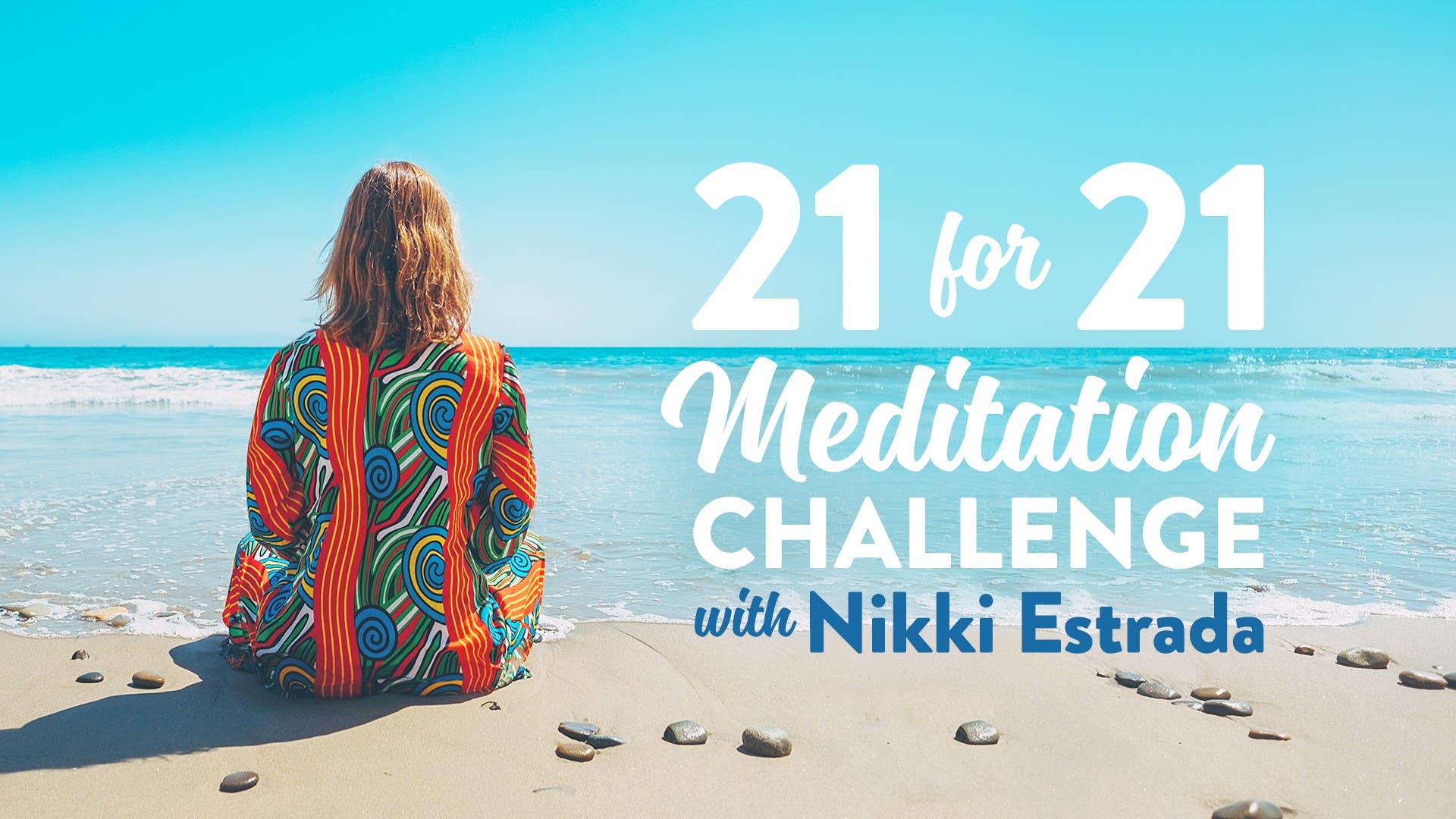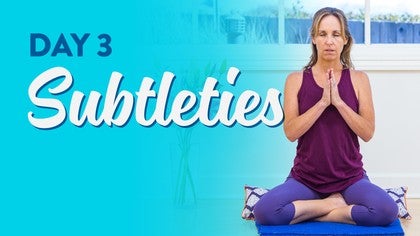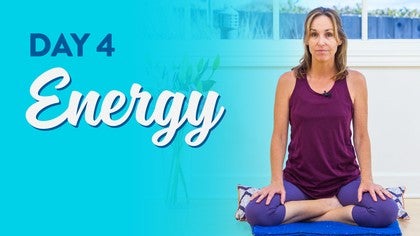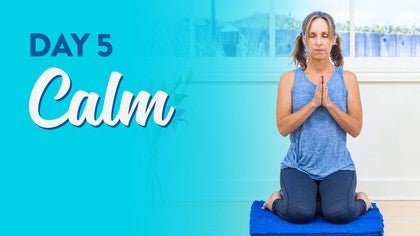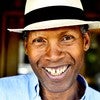Description
About This Video
Transcript
Read Full Transcript
Welcome to day three of your meditation challenge. So you may be experiencing a number of things now and one of them might be the physical challenge of sitting. So if you're noticing any achiness in your hips, achiness in your knees, too much pressure on your feet, feet falling asleep even, consider upping your elevation, sitting on a little more lift or supporting your knees with something, blocks or blankets. If physical discomfort is building, I want you to prop yourself so you feel good here. So get set up, do what you need to do in terms of your seat, choose how you're placing your feet and let's begin.
Close your eyes. We're going to follow a similar technique to our first two meditations, but with a little bit more space between my instructions. So as you close your eyes, sit tall, placing your hands in a comfortable way. As we've done before, begin at your feet, relaxing, observing, softening, begin that journey up your body through your shins and calves, going up the lower legs, across both knees and into the upper legs, into your thighs. Relaxing the muscle, muscles move the bones, so let the muscles soften, take a break and the bones can descend.
Keep lifting your awareness up the legs and into the hips and into the base of your pelvis. Feel where the weight is resting on the sitting bones. Adjust if you need to, either be centered with the weight on the sitting bones or even slightly towards the front edge of your sitting bones, not the back edge. That means your pelvis is rolling backwards, so centered or frontside of your sitting bones. Once again, pausing to feel from the sitting bones downward your foundation, grounded, stable, heavy.
And then the awareness of your pelvis, that base in that bowl, nice and leveled and centered. Top of the sacrum moves in to counter our tendency to collapse into the low back. Your tilt over time is really uncomfortable for your lower spine. And then not only are you aligning the pelvis in terms of the bones, but relax the contents, relax the abdominal muscles, relax through the digestive system. And then spine moving up and along lower back, towards the mid back, towards the upper back, which is called the thoracic spine.
Keep moving up between the shoulder blades, up, up, up to the base of your neck. Pausing to align and be aware of the shoulder girdle, collar bones wide, gently move the fronts of the shoulders, the shoulder heads back to align with your ears, but allow the shoulder blades to gently widen and to move down. And then back to the cervical spine, the neck, from the base of the neck, move in and up through that inward curvature to the base of your skull, cross the back of the head to the crown of the head. And that sense of lifting even beyond your own spine. And then down the front body, softening the forehead, softening your face and your eyes, removing any tension or expression from the face, and even adjusting your mouth, teeth together, tension free, tongue to the roof of the mouth to rest.
Relax all four sides of the neck and the throat. Once again, feel the blades moving down, the scapula sliding down, so the tops of the shoulders are soft. Chest expansive, wide through the front, home of the heart and the lungs. And moving down the rib cage, down the front body through the torso, back to the navel, navel center, soft, belly soft. And again, coming full circle through the physical, back to your base, to your foundation.
Hips, sitting bones, thighs drop down, shins, calves, feet, heavy and relaxed. Looking from the outer layer, the physical body, towards the more internal layers. First observation, emotional content. This is a big one. Can you stay relaxed and present and just notice, like a neutral witness, noticing what's happening on the inside.
Some days the meditation is so wonderful, and the internal experience is joyful, easy, and almost free. Other days it's a radically different experience. All sorts of challenging emotions arise. Just stay present and observe without trying to change. Looking for what is, is a key piece of your meditation experience.
Now from the emotional content to the mental, it's your mind state like today, it's actually the nature of the mind to be active and busy. All of us are challenged to get quiet. So what is the mind like right now? And then perhaps for you, this is even more subtle, current, energetic state. We are all made up of prana, energy, different kinds and qualities of energy.
What's your current energetic state? How is or isn't the prana flowing through you today? What does it feel like? Longer and more you meditate, the more sensitive to energy you will become. Your own and others.
Now turning attention from that general state of prana to the witnessing of your breathing. Actually energy rides on the breath, simply noticing your breathing right now. Not pranayama in the sense of controlling your breath but natural breath. It's a very common meditative tool because the breath is always happening in present time. It's even a technique from the yoga sutras, tanjali sutras, observing the flow of breath and particularly the spaces in between and in particular that moment after exhalation before inhalation.
So at first it's this general awareness of your breath, then it becomes more subtle. Not just am I on inhale, am I on exhale. How about those little tiny spaces in between. Moment of pause, it's called a kumbhaka. Moment of pause between inhale and exhale after exhale before inhale.
So let's use this technique, let's stay with it. Let's try about five minutes of pure silence. Remember to stay tall and to not slouch and if anything in your body needs readjusting, readjust and then get still again. Exhaling the breath. Exhaling the breath.
Exhaling the breath. Exhaling the breath. Exhaling the breath. Exhaling the breath. Exhaling the breath.
Exhaling the breath. Exhaling the breath. Exhaling the breath. Exhaling the breath. Whatever's arising in your mind or in your body or anything, keep coming back to the technique of your breath.
Most moments here, keep anchoring in the awareness of your breathing. And then finally again, returning brief observation, emotional happenings, mind state, energy body, energy flow, current energy state, and then that deepest, most internal experience and really what meditation and yoga is guiding us towards. It has many different names but spiritual connection, place internally that's clear and balanced and free of conflict. Let's bring our hands together at the heart, closing the practice now, namaste. And thank you for the third meditation, I'm curious how it's going, what obstacles you're facing, what's arising physically, mentally, emotionally.
So check in, let me know how it's going and any questions that you might have. Thank you.
21-Day Meditation Challenge
Comments
You need to be a subscriber to post a comment.
Please Log In or Create an Account to start your free trial.
